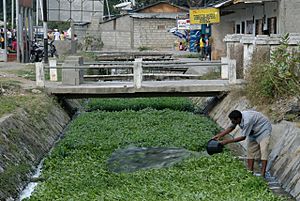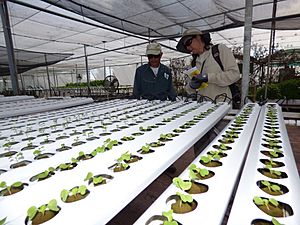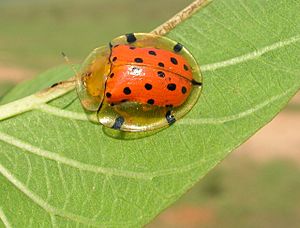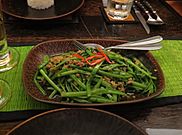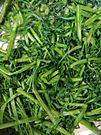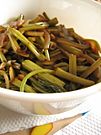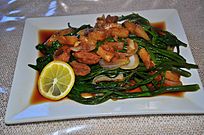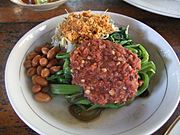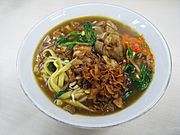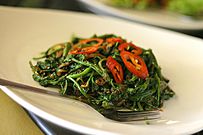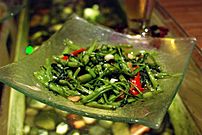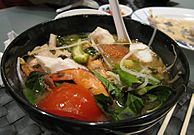Ipomoea aquatica facts for kids
Quick facts for kids Ipomoea aquatica |
|
|---|---|
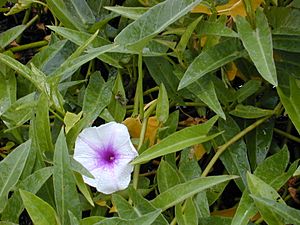 |
|
| Conservation status | |
| Scientific classification | |
| Genus: |
Ipomoea
|
| Species: |
aquatica
|
Ipomoea aquatica, also known as water spinach, is a special plant that loves water. It grows in warm, tropical places. People grow it as a vegetable because its young shoots are tasty. Many believe it was first grown by people in Southeast Asia. Today, you can find it growing in Southeast Asia, East Asia, and South Asia. It grows easily near rivers and streams and doesn't need much looking after.
Contents
What is Water Spinach?
Water spinach can grow in water or in wet soil. Its stems can be 2 to 3 meters (about 6 to 10 feet) long. They are hollow, which helps them float, and they can grow roots from different spots along the stem. The leaves look like arrowheads or long, narrow shapes. They are usually 5 to 15 cm (2 to 6 inches) long and 2 to 8 cm (1 to 3 inches) wide.
Flowers and How it Grows
The flowers of water spinach look like trumpets. They are about 3 to 5 cm (1 to 2 inches) wide. Most are white with a purple center. You can grow new plants in two ways. You can plant pieces of the stem, which will grow roots. Or, you can plant the seeds that come from the flowers.
Names for Water Spinach
The most common name for Ipomoea aquatica is kangkong or kangkung. This name comes from Southeast Asia. It's also called water spinach, river spinach, or water morning glory. Sometimes, people call it Chinese spinach or swamp cabbage.
In different places, it has other names:
- In Cantonese and Hawaii, it's ong choy.
- In Mandarin, it's kōngxīncài.
- In Tamil, it's vallal.
Where Did Water Spinach Come From?
Scientists aren't completely sure where water spinach first came from. But most people think it started in Southeast Asia. It grows best in the climate there. Also, many different names for it come from Southeast Asian languages. This suggests it has been used there for a very long time.
Some people thought it might have come from China or India. But there isn't much proof for this. An old Chinese book from about 300 AD called it a "strange vegetable of the south." It said the plant came from "western countries." This means it probably wasn't from China originally.
Growing Water Spinach
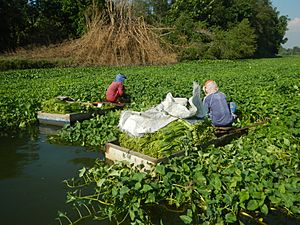

Water spinach is grown a lot in East, South, and Southeast Asia. It grows naturally in wet places and doesn't need much care. It's a very popular vegetable in many Asian countries. During World War II, it grew easily in Singapore and became an important food.
Where it is Grown
Water spinach is grown in many countries, including:
In the United States, it is grown in California, Florida, Hawaii, Texas, and Arizona. It also grows in Africa.
What Water Spinach Needs to Grow
Water spinach loves warm weather. It grows best in tropical and subtropical climates. It doesn't like temperatures below 24°C (75°F) and can't handle frost. It needs a lot of moisture in the soil. Clay or marshy soils with rich organic matter are best. The soil should also have a pH between 5 and 7. Giving the plants some shade can help them grow even better.
Traditional Growing Methods
In Hong Kong, people use two main ways to grow water spinach:
- Dryland Method: Plants are grown on raised beds with ditches for water. Seeds can be planted directly or started in a nursery. Plants are spaced about 12 cm (5 inches) apart. They need regular watering and fertilizer. You can harvest them 50 to 60 days after planting by pulling up the whole plant.
- Wetland Method: This is more common. Water spinach is grown in flat fields that used to be rice paddies. These fields have heavy clay soil that holds water well. Seedlings are started in a nursery because seeds don't grow well underwater. After six weeks, pieces of the stem about 30 cm (12 inches) long are cut. These pieces are planted in the flooded field. The field is flooded with 3 to 5 cm (1 to 2 inches) of water. Once the plants grow, the water level is raised to 15 to 20 cm (6 to 8 inches). The first harvest is about 30 days after planting. You cut the top part of the main stem. This makes the plant grow more side shoots. You can then harvest these shoots every 7 to 10 days during summer. After the growing season, the fields are drained. The plant's fruit is harvested, dried, and the seeds are collected for next year.
Plant Problems and Pests
Like all plants, water spinach can have problems with diseases and bugs. Some diseases can cause seedlings to die or leaves to get spots. Tiny bugs called aphids can also be a problem. There are also different kinds of caterpillars and other insects that like to eat water spinach leaves.
Is Water Spinach Invasive?
In some places, like Florida, California, and Hawaii in the United States, water spinach is considered a "noxious weed." This means it can grow very fast and take over areas, sometimes harming native plants. It can block waterways and make it hard for boats to pass.
However, in Texas, it has been grown for over 30 years by Asian immigrants. Since it hasn't spread out of control there, Texas now allows people to grow it for personal use. They also allow commercial growing with a special permit. This shows how important it is as a vegetable in many cultures.
Cooking with Water Spinach
| Nutritional value per 100 g (3.5 oz) | |
|---|---|
| Energy | 79 kJ (19 kcal) |
|
3.14 g
|
|
| Dietary fiber | 2.1 g |
|
0.2 g
|
|
|
Protein
|
2.6 g
|
| Vitamins | Quantity
%DV†
|
| Vitamin A equiv. |
39%
315 μg |
| Thiamine (B1) |
3%
0.03 mg |
| Riboflavin (B2) |
8%
0.1 mg |
| Niacin (B3) |
6%
0.9 mg |
| Pantothenic acid (B5) |
3%
0.141 mg |
| Vitamin B6 |
7%
0.096 mg |
| Folate (B9) |
14%
57 μg |
| Vitamin C |
66%
55 mg |
| Minerals | Quantity
%DV†
|
| Calcium |
8%
77 mg |
| Iron |
13%
1.67 mg |
| Magnesium |
20%
71 mg |
| Manganese |
8%
0.16 mg |
| Phosphorus |
6%
39 mg |
| Potassium |
10%
312 mg |
| Sodium |
8%
113 mg |
| Zinc |
2%
0.18 mg |
|
Link to USDA Database entry
|
|
| †Percentages estimated using US recommendations for adults. | |
Water spinach is a very common ingredient in Asian cooking. People often stir-fry it.
- In Singapore, Indonesia, and Malaysia, people stir-fry the tender shoots and leaves. They add chili pepper, garlic, ginger, and shrimp paste (called belacan or terasi).
- In Penang, it's cooked with cuttlefish and a sweet and spicy sauce.
- In Burmese cuisine, it's used in a salad called gazun ywet thoke. This salad has blanched water spinach, lime juice, fried garlic, and dried shrimp.
- In Indonesian cuisine, it's called kangkung. It's boiled or blanched and used in salads like gado-gado with peanut sauce. Recipes like plecing kangkung and mie kangkung (kangkong noodle) also use it.
- In Thailand, it's called phak bung. It's eaten raw with green papaya salad or in stir-fries and curries.
- In the Philippines, it's called kangkóng. It's cooked in stews like sinigang. A popular dish is adobong kangkóng, where it's sautéed with onions, garlic, vinegar, and soy sauce. Another dish is ensaladang kangkóng, which is blanched water spinach with vinegar, calamansi juice, tomatoes, and onions. There's also binagoongang kangkóng, cooked with garlic and shrimp paste. A fun snack is crispy kangkóng, where the leaves are fried until crunchy.
-
Chinese kōngxīncài
-
Filipino ensaladang kangkóng
-
Indonesian plecing kangkung from Lombok
-
Indonesian mie kangkung (with noodles)
-
Malaysian-style kangkung belacan
-
Thai phak bung fai daeng
-
Vietnamese canh chua
Other Uses for Water Spinach
Cleaning Water
Water spinach can help clean dirty water. It can remove extra nutrients from wastewater. This helps control too much algae growth in freshwater. Because it's edible, it's a good choice for this kind of "plant-based cleaning."
Animal Food
Water spinach is also fed to animals like cattle, pigs, fish, ducks, and chickens. It's a good source of nutrients for them, especially the leaves, which have a lot of carotene.
Images for kids
-
I. aquatica along the Angat River, Philippines
-
Ipomoea aquatica at Nakhonsawan school, Nakhon Sawan, Thailand
-
I. aquatica with white flowers in Sai Kung, Hong Kong
-
Cattle egrets among I. aquatica in Norzagaray, Philippines
-
I. aquatica being sold in a market in Hong Kong
-
Bundles of I. aquatica being sold by a roadside vendor in Makati City, Philippines
See also
 In Spanish: Ipomoea aquatica para niños
In Spanish: Ipomoea aquatica para niños



